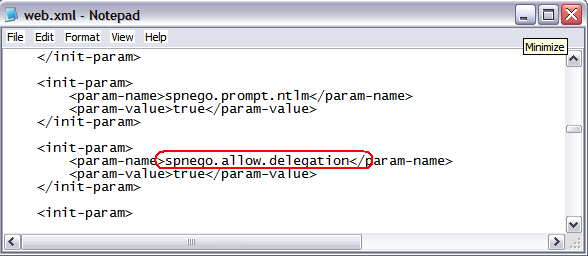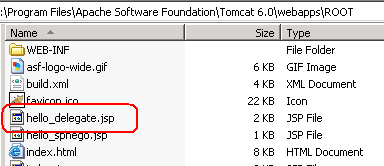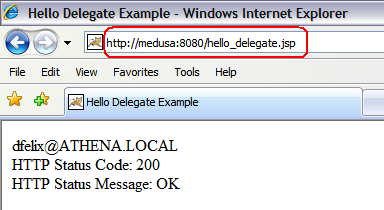Delegating Credentials to an Application ServerOne common use-case of credential delegation is where a client chooses to allow a server to authenticate to and perform actions on a second server as the client. Example use-case An Administrative Assistant opens her IE Browser (client) and goes to her company's intranet (server). The intranet has a feature where she can schedule reports to be printed later that night. This allows her to go home early and avoid having to wait until the system is done processing the day's transactions.
The reporting server runs on a (second server) different host than the intranet server. The reporting server maintains certain preferences based on who is running the report. Because of this, later that night when the intranet server connects to the reporting server to run a report, the reporting server will think it's the admin assistant running the report. Hence, the report will be printed after applying the admin assistant's preferences: the right printer, in the right font-size, stapled, etc.
Before Getting Started Be sure that you have read and successfully performed ALL of the steps in the pre-flight documentation before proceeding any further. It is imperative that you perform all steps in the pre-flight since we will be using files that we created from that guide. If you don't already have a working app server that authenticates requests via Kerberos/SPNEGO, take a look at the installing Tomcat or installing JBoss example. You will need to do this twice since this example requires one client machine and two (2) servers. Allowing Delegation By default, Internet Explorer (IE) and Active Directory (AD) have delegation enabled. However, there are a few steps that need to be performed before credential delegation can occur. The pre-flight documentation describes a pre-authentication Windows Domain Account that the app server uses to authenticate client requests. This pre-authentication account must be specified in Active Directory as "Account is trusted for delegation". 
The SPNEGO Http Servlet Filter's init params in the app server's web.xml file will also need to be modified to allow delegation. 
Taking the example use-case from earlier, only the intranet server needs to be allowed for delegation. Meaning, only the intranet server's pre-auth account and the intranet server's web.xml file needs to be modified. Creating hello_delegate.jsp If you are installing on Tomcat, create the following
hello_delegate.jsp file under the
<!DOCTYPE HTML PUBLIC "-//W3C//DTD HTML 4.01 Transitional//EN">
<%@ page import="java.net.*" %>
<%@ page import="org.ietf.jgss.*" %>
<%@ page import="net.sourceforge.spnego.*" %>
<html>
<head>
<title>Hello Delegate Example</title>
</head>
<body>
<%
if (request instanceof DelegateServletRequest) {
DelegateServletRequest dsr = (DelegateServletRequest) request;
GSSCredential creds = dsr.getDelegatedCredential();
if (null == creds) {
out.print("No delegated creds.");
} else {
out.print(creds.getName().toString());
SpnegoHttpURLConnection spnego =
new SpnegoHttpURLConnection(creds);
spnego.connect(new URL("http://perseus.athena.local:8080/hello_spnego.jsp"));
out.print("<br />HTTP Status Code: " + spnego.getResponseCode());
out.print("<br />HTTP Status Message: " + spnego.getResponseMessage());
spnego.disconnect();
}
} else {
out.print("Request not a delegate.");
}
%>
</body>
</html>

Notice from the jsp code above that it is making a call to the second server named
Also, notice that the delegation example code did NOT have to be implemented as a .jsp file. We could have implemented this as a Servlet Filter, a Servlet or a Custom Tag. Testing hello_delegate.jsp Before running the hello_delegate.jsp, confirm that your first server and second server are working as expected by running the hello_spnego.jsp file. First Server: 
Second Server: 
Notice from above that the first server is named We will now run the hello_delegate.jsp code on 
If all is working as expected, you should see the Recall that the client is only making a call to the server named
... Nov 1, 2009 6:38:29 PM org.apache.jk.server.JkMain start INFO: Jk running ID=0 time=0/30 config=null Nov 1, 2009 6:38:29 PM org.apache.catalina.startup.Catalina start INFO: Server startup in 1439 ms Nov 1, 2009 6:38:41 PM net.sourceforge.spnego.SpnegoHttpFilter doFilter FINE: principal=dfelix@ATHENA.LOCAL ... As you can see, IE has allowed the user's credentials to be delegated to Troubleshooting hello_delegate.jsp If you did not get an output similar to the above, take a look at the Troubleshooting hello_delegate.jsp page.
Links:
Troubleshooting:
Examples:
Licensing:
© 2009 Darwin V. Felix. All rights reserved.
|